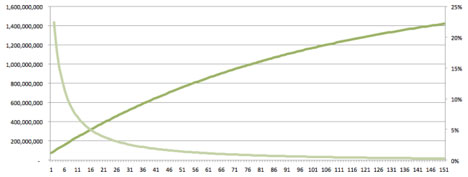Ether (ETH), the cryptofuel that powers distributed purposes on the Ethereum platform, can be issued at a relentless annual linear charge by way of the block mining course of. This charge is 0.3 occasions the whole quantity of ETH that can be bought within the pre-sale.
Whereas the perfect metaphor for ETH is “gasoline for working the contract processing engine,” for the needs of this put up, we’ll deal with ETH purely as a foreign money.
There are two widespread definitions of “inflation.” The primary pertains to costs and the second pertains to the whole amount of cash in a system – the financial base or provide. Equally for the time period “deflation.” On this put up we’ll distinguish between “worth inflation,” the rise within the common worth degree of products and companies in an financial system, and “financial inflation,” the expansion within the provide of cash in an financial system on account of some kind of issuance mechanism. Usually, however not at all times, financial inflation is a explanation for worth inflation.
Although the issuance of ETH is in a set quantity every year, the speed of development of the financial base (financial inflation) isn’t fixed. This financial inflation charge decreases yearly making ETH a disinflationary foreign money (when it comes to financial base). Disinflation is a particular case of inflation through which the quantity of inflation shrinks over time.
It’s anticipated that the quantity of ETH that can be misplaced every year attributable to transmissions to addresses that are now not accessible is estimated to be on the order of 1% of the financial base. ETH could also be misplaced on account of lack of non-public keys, dying of proprietor with out transmission of personal keys, or purposeful destruction by sending to an tackle that by no means had an related non-public key generated.
If we assume that Ethereum sells 40,000 BTC price of ETH within the pre-sale, and if we assume that the typical worth is 1500 ETH/ BTC, 60,000,000 ETH can be created within the genesis block and assigned to purchasers. Yearly, in perpetuity, 18,000,000 ETH can be issued although the mining course of. Taking into consideration each creation of latest ETH and lack of current ETH, within the first yr, this represents a financial inflation charge of twenty-two.4%. Within the second yr the speed drops to 18.1%. By the tenth yr, the speed is 7.0%. In yr 38, it hits 1.9%. And within the sixty fourth yr, the extent of 1.0% is reached.

Determine 1. Quantity of ETH in existence (darkish inexperienced curve) on the left axis. Financial base inflation charge (gentle inexperienced curve) on the precise axis. Years on the horizontal axis. (Tailored from Arun Mittal with thanks.)
By roughly the yr 2140, the issuance of BTC ceases and since some BTC will seemingly be misplaced every year, the financial base of Bitcoin is predicted to begin shrinking at that time.
At roughly the identical time, the anticipated charge of annual loss and destruction of ETH will stability the speed of issuance. Beneath this dynamic, a quasi-steady state is reached and the quantity of extant ETH now not grows. If the demand for ETH remains to be rising at that time on account of an increasing financial system, costs can be in a deflationary regime. This isn’t an existential drawback for the system since ETH is theoretically infinitely divisible. So long as the speed of worth deflation isn’t too fast, pricing mechanisms will alter and the system will function easily. The standard foremost objection to deflationary economies, wage stickiness, is probably going to not be a problem since all funds methods can be fluid. One other frequent objection, debtors pressured to repay loans with a foreign money that grows in buying energy over time, may also not be an issue if this regime is persistent, since phrases of lending can be outlined to account for this.
Notice that whereas the financial inflation stays larger than zero for a few years, worth ranges (tracked as worth inflation and deflation) are depending on provide and demand, so are associated to, however not completely managed by the speed of issuance (provide). Over time it’s anticipated that development of the Ethereum financial system will considerably outpace development of the availability of ETH, which might result in a rise within the worth of ETH with respect to legacy currencies and BTC.
One among Bitcoin’s nice worth propositions was the algorithmically mounted whole issuance of the foreign money which mandated that solely 21,000,000 BTC will ever be created. In a time of profligate legacy foreign money printing in an exponentially doomed try and patch over the truth that there’s an excessive amount of debt within the international financial system (with extra debt), the prospect of a universally accepted cryptocurrency that may serve finally as a comparatively steady retailer of worth is enticing. Ethereum acknowledges this and seeks to emulate this core worth proposition.
Ethereum additionally acknowledges {that a} system supposed to function a distributed, consensus-based software platform for international financial and social methods, should strongly emphasize inclusiveness. One of many some ways we intend to foster inclusiveness is by sustaining an issuance system which possesses some churn. New members within the system will be capable of buy new ETH or mine for brand spanking new ETH whether or not they’re dwelling within the yr 2015 or 2115. We imagine we now have a achieved an excellent stability between the 2 targets of fostering inclusiveness and sustaining a steady retailer of worth. And the fixed issuance, particularly within the early years, will seemingly make utilizing ETH to construct companies within the Ethereum financial system extra profitable than hoarding speculatively.
from Ethereum – My Blog https://ift.tt/ZtP3wDz
via IFTTT

No comments:
Post a Comment